 Download PDF
Download PDF
Name: Securigera varia (L.) Lassen
Family: Fabaceae, the Pea Family
Common Names: Crown-vetch, trailing crown-vetch, axseed, purple crownvetch, axwort, field crownvetch (1,3,4,5).
Etymology: Securigera, in Latin means “armed with axe”, and varia means “variegated, colored, diverse” (9). The name of the genus refers to the shape of the fruit of Securigera securidaca (5).
Botanical synonyms: Coronilla varia L. (1).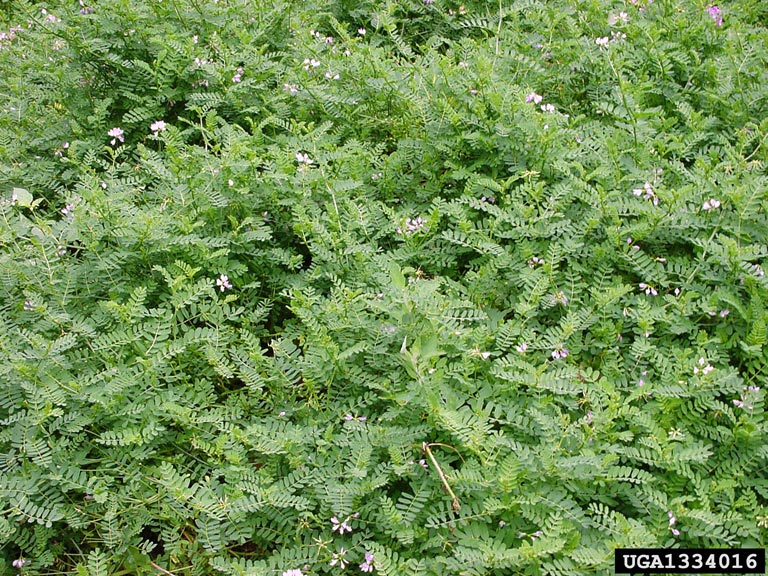
Quick Notable Features:
¬ Mat-forming herb with glabrous, angular stems and alternate leaves
¬ Odd-pinnately compound leaves with 7-25 mucronate leaflets
¬ Axillary umbels of pink flowers
¬ Legumes with 3-12 segments, with a single brown seed per segment
Plant Height: Usually up to 0.3 m tall, but occasionally up to 1.2 m (6,8).
Subspecies/varieties recognized (11):
Securigera varia (L.) Lassen subsp. hirta (Bunge ex Boiss.) Czerep.
Securigera varia (L.) Lassen subsp. orientalis (Hrabětová) Czerep.
Most Likely Confused with: Vicia ssp., Lathyrus ssp., Chamaecrista fasciculata, Lotus corniculatus.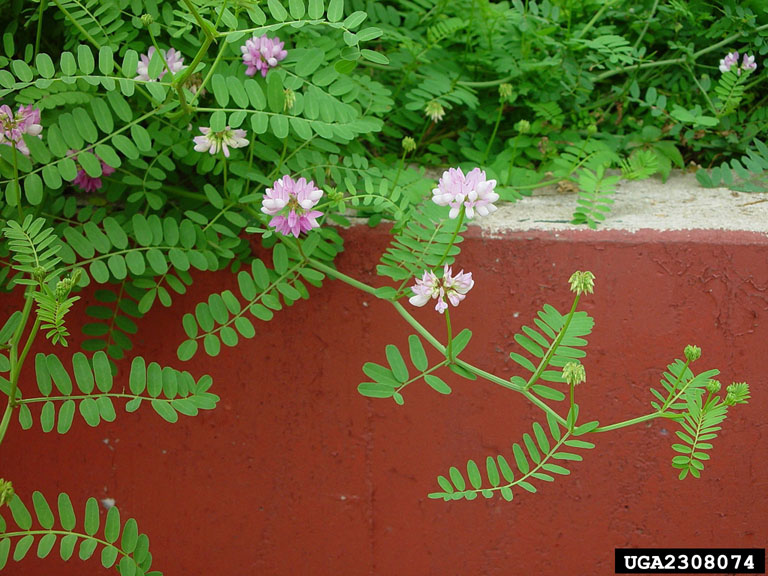
Habitat Preference: Although it prefers well-drained soils with neutral or alkaline pH and high sun exposure, the crown-vetch tolerates slightly acidic, nutrient poor soils, drought, and partial shade. S. varia grows along roads, in abandoned fields, and forest edges (7,8).
Geographic Distribution in Michigan: As of February 2014, S. varia has been reported in 24 counties scattered throughout the Lower Peninsula, and in 3 counties in the Upper Peninsula: Mackinac, Delta, and Marquette (3).
Known Elevational Distribution: In Bolívar, Ecuador, S. varia grows to elevations of 3609 meters (1).
Complete Geographic Distribution: Native to the Mediterranean region, S. varia was introduced in North America, and northern Europe. In the United States, it is found in every state but Alaska, North Dakota, Puerto Rico, and Virgin Islands. In Canada, it is found in AB, BC, MB, NB, NF, NS, ON, PE, QC, and SK (4,5).
Vegetative Plant Description: Crown-vetch is 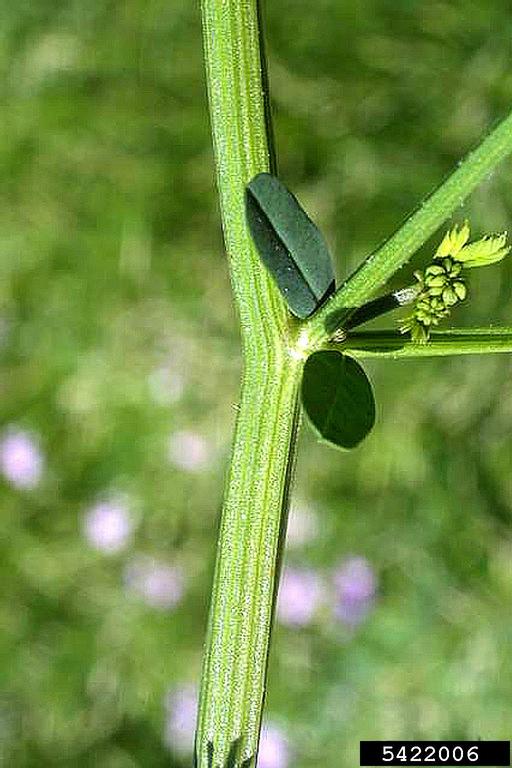 an herbaceous plant with trailing to ascending, mat-forming stems, and perennial rhizomes up to 3 m long. Branching angular stems (0.3-2 m long) bear longitudinal, parallel grooves and are often glabrous, although some plants are slightly pubescent. The deciduous leaves are alternate, pinnately compound with 7-25 leaflets, 4-16 cm long, sessile, and subtended by a pair of free stipules (1-6 mm long) that are thin, oblong, mucronate, and apically dark. The leaflets are sessile, oblong to ovate, basally narrow to round, apically obtuse and mucronate, 0.8-3 cm long, ~0.6 cm broad, and dark green with thin, entire margins (5,6,7,8,15,16,17,18).
an herbaceous plant with trailing to ascending, mat-forming stems, and perennial rhizomes up to 3 m long. Branching angular stems (0.3-2 m long) bear longitudinal, parallel grooves and are often glabrous, although some plants are slightly pubescent. The deciduous leaves are alternate, pinnately compound with 7-25 leaflets, 4-16 cm long, sessile, and subtended by a pair of free stipules (1-6 mm long) that are thin, oblong, mucronate, and apically dark. The leaflets are sessile, oblong to ovate, basally narrow to round, apically obtuse and mucronate, 0.8-3 cm long, ~0.6 cm broad, and dark green with thin, entire margins (5,6,7,8,15,16,17,18).
Climbing Mechanism: S. varia climbs by scrambling over adjacent vegetation and rocks (7).
Flower Description: The inflorescences of S. varia (~ 2.5 cm across) are axillary umbels of 10-25 conspicuous papilionaceous flowers, rarely as few as 2, on 5-15 cm long peduncles that are usually longer than the subtending leaves. Each perfect flower is borne on a 0.3-0.7 cm pedicel and subtended by a minute scale-like bract. Calices are campanulate, glabrous, 0.2-0.3 cm long, and 5-parted: the 2 upper lobes are partially fused, and the 3 lower are free. Corollas (0.8-1.5 cm long) have 5 long-clawed petals: an orbicular, pink to lilac standard; 2 free, ovate to oblong, whitish wing petals; and 2 apically purple, curved, fused petals (the keel). Stamens are diadelphous, with 9 of the 10 stamens united by the filaments, and one free. The unilocular, superior ovary is sessile with a single style and stigma (5,6,7,15,16,17,18).
Flowering Time: In the U.S., S. varia flowers from May to September (7,8).
Pollinator: The showy and fragrant flowers of crown vetch are pollinated by honeybees and other insects (8,14).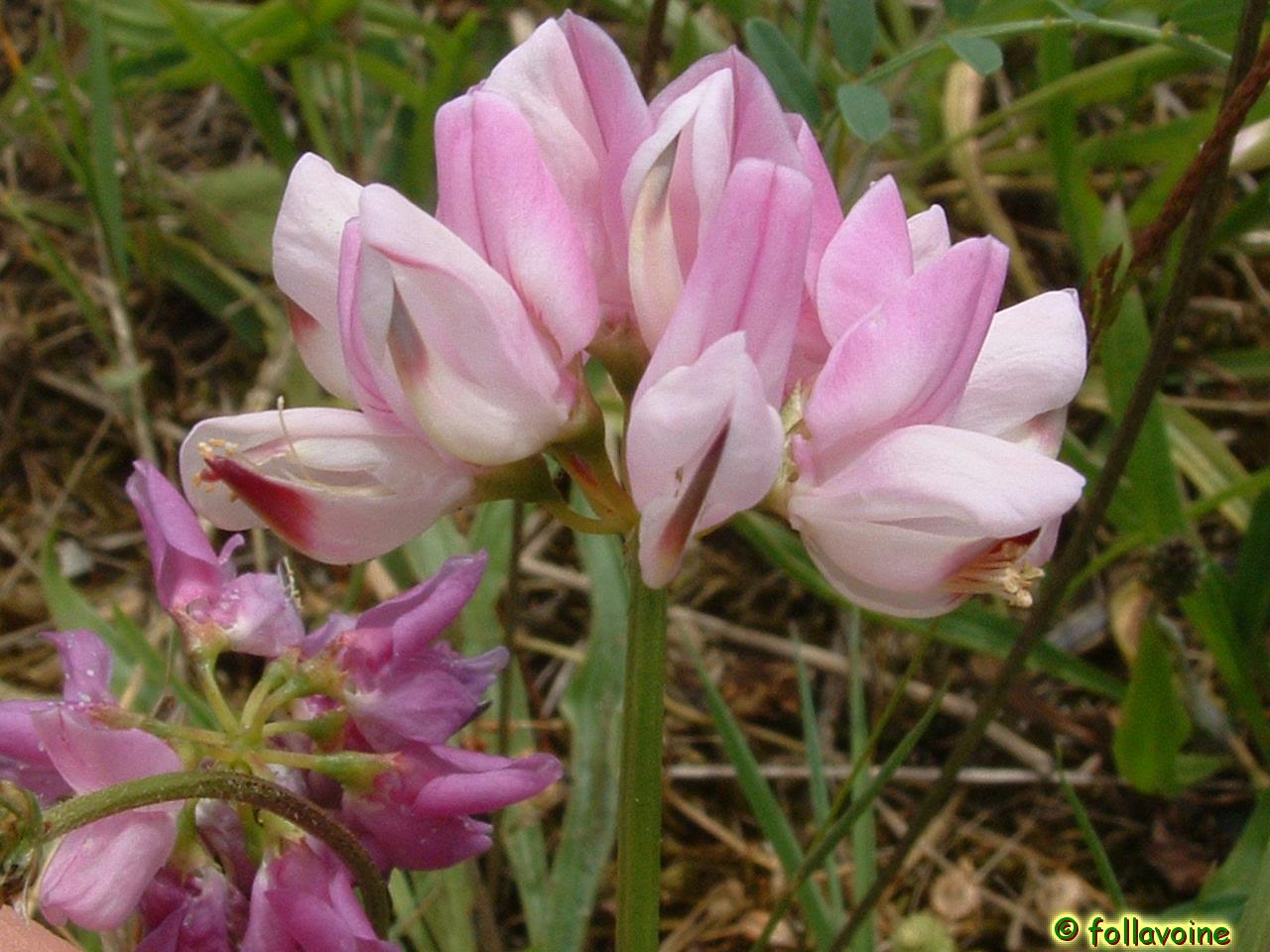
Fruit Type and Description: The fruit of the crown-vetch is a slender legume divided into 3-12 single-seeded segments; each segment is 4-8 mm long. The indehiscent legumes are coriaceous, 4-angled, 1.5-10 cm long, and mature as they change from light green to brown (6,7,8,15,16,17).
Seed Description: The flattened-cylindrical seeds of S. varia are brown, approximately 3-4 mm long and 1-1.2 mm broad (7,8,18).
Dispersal Syndrome: The seeds are consumed by animals, such as deer, and remain viable after passing through their digestive tract. Animals are responsible for long distance dispersal. When the fruits of S. varia mature, the segments dry, break, and may fall near the parent plant. The species also spreads vegetatively by rhizomes (7,8,18).
Distinguished by: Vicia ssp. leaves are subtended by semi-sagittate to lanceolate stipules, and terminate in a tendril. The inflorescence of Vicia species are racemes of 1-many flowers, and the legumes are not segmented. S. varia leaves are subtended by oblong stipules and bear a terminal leaflet; tendrils are absent. The inflorescence of S. varia is an umbel of usually more than 10 flowers, and its legumes are segmented. Lathyrus species, like Vicia species, are also 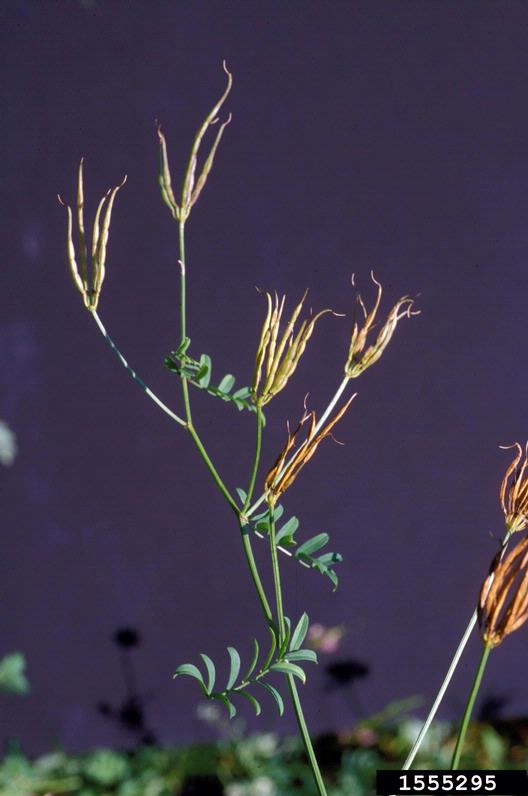 differentiated by a terminal tendril instead of a terminal leaflet, a raceme inflorescence, and non-segmented legumes. The stipules of Lathyrus ssp. are hastate to semi-sagittate and generally more than 7mm broad, while in S. varia they are only up to 6 mm long. Chamaecrista fasciculata leaves have an even number of leaflets, its flowers are yellow and caesalpinioid, the stamens are free, and the legumes not segmented. S. varia leaves have an odd number of leaflets (terminal leaflet present), and the flowers are whitish-pink to purple, papilionaceous, and stamens are diadelphous. Lotus corniculatus leaves have only 5 leaflets, 2 of which resemble stipules. The flowers of L. corniculatus are borne in umbels, however they are yellow and later produce dehiscent and non-segmented legumes. S. varia leaves have at least 7 leaflets, and the legumes are indehiscent (3,16).
differentiated by a terminal tendril instead of a terminal leaflet, a raceme inflorescence, and non-segmented legumes. The stipules of Lathyrus ssp. are hastate to semi-sagittate and generally more than 7mm broad, while in S. varia they are only up to 6 mm long. Chamaecrista fasciculata leaves have an even number of leaflets, its flowers are yellow and caesalpinioid, the stamens are free, and the legumes not segmented. S. varia leaves have an odd number of leaflets (terminal leaflet present), and the flowers are whitish-pink to purple, papilionaceous, and stamens are diadelphous. Lotus corniculatus leaves have only 5 leaflets, 2 of which resemble stipules. The flowers of L. corniculatus are borne in umbels, however they are yellow and later produce dehiscent and non-segmented legumes. S. varia leaves have at least 7 leaflets, and the legumes are indehiscent (3,16).
Other members of the family in Michigan (number species): Amorpha (2), Amphicarpaea (1), Anthyllis (1), Apios (1), Astragalus (3), Baptisia (3), Caragana (1), Cercis (1), Chamaecrista (2), Crotalaria (1), Cytisus (1), Dalea (2), Desmanthus (1), Desmodium (12), Galega (1), Gleditsia (1), Glycine (1), Gymnocladus (1), Hedysarum (1), Hylodesmum (2), Kummerowia (1), Lathyrus (10), Lespedeza (9), Lotus (1), Lupinus (3), Medicago (3), Melilotus (3), Mimosa (1), Orbexilum (1), Phaseolus (2), Pisum (1), Pueraria (1), Robinia (2), Senna (2), Strophostyles (1), Tephrosia (1), Trifolium (10), Vicia (10), Vigna (1), Wisteria (2) (source 3).
Ethnobotanical Uses: The crown-vetch is used for erosion control due to its extensive root system, as a green crop, nitrogen enhancer, ornamental plant, and as animal forage, although with caution as S. varia is poisonous to many species including humans, especially horses. Due to its toxicity, the species is not edible for humans, and it is used as insecticide. A few medicinal uses of the plant have been listed, but caution is advised because the plant is toxic. A tonic effect for the heart can be obtained by consuming the whole plant, fresh or dry. A tea can be prepared with the peels of the stem and used to induce vomiting. The plants can be mashed and applied to joints to alleviate rheumatism (5,10,13).
Phylogenetic Information: The genus 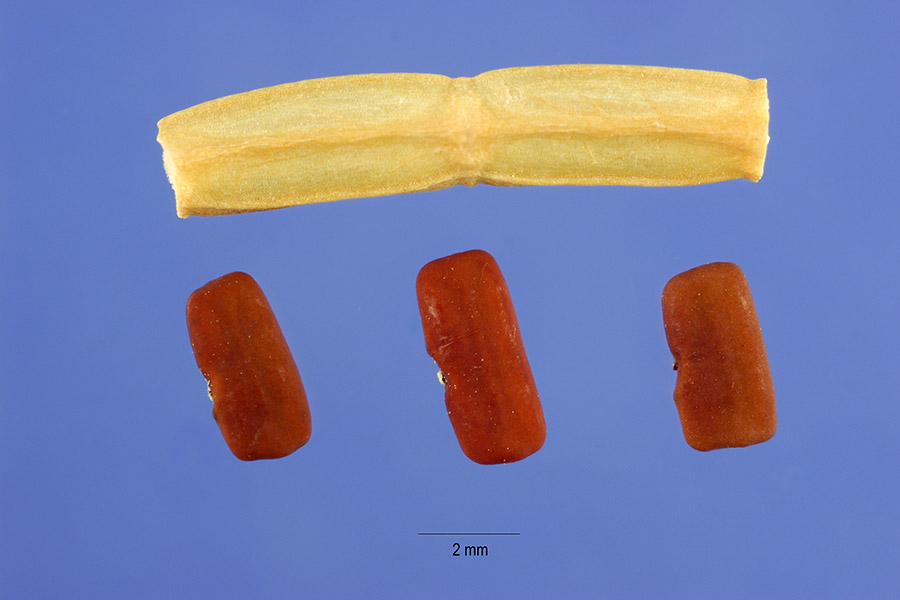 Securigera is a member of the subfamily Faboideae in the Fabaceae family, which is in the order Fabales, part of the Rosids I, Core Eudicots. Members of the Fabaceae family are distributed worldwide, and the family contains approximately 9.4% of all eudicots and 16% of all known woody plants found in neotropical rainforests (2).
Securigera is a member of the subfamily Faboideae in the Fabaceae family, which is in the order Fabales, part of the Rosids I, Core Eudicots. Members of the Fabaceae family are distributed worldwide, and the family contains approximately 9.4% of all eudicots and 16% of all known woody plants found in neotropical rainforests (2).
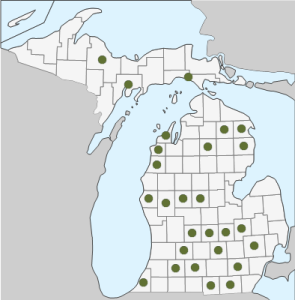 Interesting Quotation or Other Interesting Factoid not inserted above:
Interesting Quotation or Other Interesting Factoid not inserted above:
S. varia was first reported in the U.S. in New York in 1869. The species is especially invasive in the Midwest (8). The crown-vetch is also considered a high priority invasive species of the Fabaceae family in Mexico (12). Symstad (2004) studied the effects of the invasion of S. varia in a sand prairie on native species richness and abundance, soil nitrogen availability, and on the establishment of another non-native species, Poa pratensis (Kentucky bluegrass). S. varia caused a decrease in native species richness and abundance even after one year of reduction in S. varia populations. In spite of S. varia reductions, nitrogen availability in the soil remained relatively high. P. pratensis population did not decrease while S. varia was present, but after the population of S. varia was reduced, the non-native grass increased its covered area by almost 6 times. The author concluded that even after removal of S. varia, the species has effects on the ecosystem via creating improved conditions for other non-natives and thus has an indirect effect of decreasing native species richness and cover. These findings are important for ecosystem restoration where S. varia is present (13).
Literature and websites used:
- Tropicos.org. Missouri Botanical Garden. 15 Feb 2014 http://www.tropicos.org/Name/13075242
- Stevens, P.F. Angiosperm Phylogeny Website. Version 12, July 2012. http://www.mobot.org/mobot/research/apweb.
- Michigan Flora Online. A.A. Reznicek, E.G. Voss, & B.S. Walters. February 2011. University of Michigan. Web. February 15, 2014. http://michiganflora.net/species.aspx?id=1282.
- USDA, NRCS. 2014. The PLANTS Database (http://plants.usda.gov, 02/15/2014). National Plant Data Team, Greensboro, NC 27401-4901 USA.
- Burrows, G.E. & R.J. Tyrl 2013. Toxic Plants of North America. Ames, Iowa: John Wiley & Sons, Inc.
- Cullen, J., S.G. Knees, & H.S. Cubey 2011. The European Garden Flora, Vol. III. New York, NY: Cambridge University Press.
- Miller, J.H., E.B. Chambliss, & N.J. Loewenstein. 2010. Field Guide for the Identification of Invasive Plants in Southern Forests. Asheville, NC: U.S.D.A. Forest Service Southern Research Station. General Technical Report SRS-119.
- Gucker, C.L. 2009. Coronilla varia. In: Fire Effects Information System [Online]. U.S. Department of Agriculture, Forest Service, Rocky Mountain Research Station, Fire Sciences Laboratory. http://www.fs.fed.us/database/feis/plants/forb/corvar/all.html
- Mahoney, K. 2002-2014. Latdic. http://www.latin-dictionary.net/search/latin/varia
- Plants For A Future, 1996-2012. Accessed: 17 February 2014. http://www.pfaf.org/user/Plant.aspx?LatinName=Coronilla+varia
- The International Plants Name Index, 2004. Last updated: December 2013. http://www.ipni.org/index.html
- Sánchez-Blanco, J., C. Sánchez-Blanco, M. Sousa S., & F.J. Espinosa-García 2012. Assessing introduced Leguminosae in Mexico to identify potentially high-impact invasive species. Acta Botanica Mexicana 100: 41-77.
- Symstad, A.J. 2004. Secondary invasion following the reduction of Coronilla varia (crownvetch) in sand prairie. The American Midland Naturalist 152(1): 183-189.
- Gustine, D.L. & B.G. Moyer 1990. Crownvetch (Coronilla varia L.). Biotechnology in agriculture and forestry 10: 341-354.
- Britton, N.L. & H.A. Brown 1970. An Illustrated Flora of the Northern United States and Canada: Volume II. New York, NY: Dover Publications, Inc.
- Fernald, M. L. 1950. Gray’s Manual of Botany, 8th ed. New York: American Book Company.
- Radford, A.E., H.E. Ahles, & C.R. Bell 1968. Manual of the Vascular Flora of the Carolinas. Chapel Hill, NC: The University of North Carolina Press.
- Alaska Natural Heritage Program 2007. Crownvetch. University of Alaska Anchorage. http://aknhp.uaa.alaska.edu/wp-content/uploads/2013/01/Coronilla_varia_BIO_COVA2.pdf
Image Credits (all used with permission):
1. Image of infestation – copyright of Chris Evans, Illinois Wildlife Action Plan, Bugwood.org, licensed by CC BY-NC 3.0 US from http://www.forestryimages.org/browse/detail.cfm?imgnum=1334016
2. Image of habit – copyright of Dan Tenaglia, Missouriplants.com, Bugwood.org licensed by CC BY-NC 3.0 US from http://www.invasive.org/browse/detail.cfm?imgnum=2308074
3. Image of stem – copyright of Steve Baskauf, Vanderbilt University Dept. of Biological Sciences, Bugwood.org licensed by CC BY-NC 3.0 US from http://www.forestryimages.org/browse/detail.cfm?imgnum=5422006
4. Image of inflorescence copyright of Follavoine, Niort (Deux-Sèvres, France) 2004 – GFDL licensed by CC-BY-SA-3.0 from http://commons.wikimedia.org/wiki/File:Coronilla_varia005.JPG
5. Image of plant with fruits copyright by John Cardina, The Ohio State University, Bugwood.org licensed by CC BY-NC 3.0 US from http://www.forestryimages.org/browse/detail.cfm?imgnum=1555295
6. Image of seed copyright of Steve Hurst from USDA-NRCS PLANTS Database at http://plants.usda.gov/java/largeImage?imageID=cova2_002_ahp.tif
7. Species distribution map, derived from the Michigan Flora Online.
Primary Author: Cristine V. Santanna, with editing by John Bradtke and Robyn J. Burnham.
© Robyn J. Burnham
For additional information on Michigan Plant Diversity species accounts, please contact Robyn J. Burnham via email: rburnham“at”umich.edu